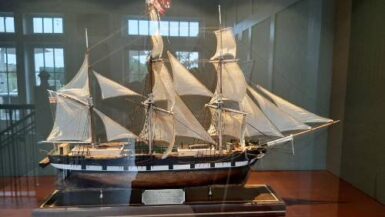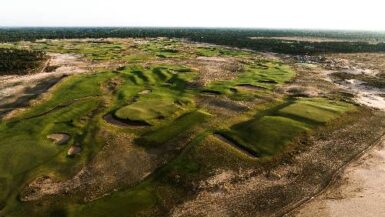GOLDEN AGE U.S. OPEN COURSES GETTING BETTER WITH AGE
Inwood Country Club, Philadelphia Cricket Club still shine
like the polished gems they were many decades ago.
With proper care, some things get better with age. A fine wine rounds out its edges and develops interesting complex flavors. Older cigars are smoother and more balanced, providing a mellow, civilized smoke. The beauty of a woman becomes refined. She turns from being merely comely to elegant, alluring, and timeless. The critical ingredient is care. Handled poorly or unwisely, the wine turns to sour grapes, the cigar dries to stale leaves, the woman becomes wrinkled and bitter.
A golf course is the same; it is a delicate living ecosystem that is ever changing and needs constant nurturing to thrive. Weather, new vegetation, erosion, animals, even just time are enemies of a golf course and threaten the fragile balance that keeps the course well conditioned. Moreover, advances in club technology have undermined the strategies of many older designs making hazards that were once the centerpiece of a hole, mere window-dressing.
Many clubs – seeking to emulate major championship conditions to either attract a pro tournament or simulate the conditions seen on television – have damaged their courses further with pointless lengthening and “beautification campaigns” (tree-planting programs) and by cutting greens and fairways to absurd stimpmeter readings.
Luckily, two of our most venerable former U.S. Open sites have swung the pendulum back to sanity and wisdom. Inwood Country Club in Queens, New York and Philadelphia Cricket Club, two of the country’s most venerable U.S. Open venues have resisted the temptation to turn their courses into bastions of machismo and unbelievable length or narrow tree-lined corridors where players must walk single file. This sane, wise approach, coupled with Oakmont’s now-famous tree elimination campaign means that private clubs are avoiding the perils of do-it-yourself course design and letting the original strategies shine through.
PHILADELPHIA CRICKET CLUB – ST. MARTIN’S COURSE
The St. Martin’s nine opened the same year as the first U.S. Open, 1895. Instead of calling some architect to “redesign” or “renovate” the course by adding length, trees or, worse still, difficulty, the course remains the same as it did over a century ago, a grassy time capsule perfectly preserved in all its homespun splendor.
It’s a special feeling any time you walk in the footsteps of history, but there was an even more idyllic feel to PCC than any other course. The blessed feeling of utter solitude despite being in the center of the city with suburbia all around us was the greatest attribute. Here is a former U.S. Open venue (1907, won by Alex Ross, brother of golf architect Donald Ross and 1910 won by Alex Smith. WIllie Anderson who won four U.S. Opens and is the only man to win three in a row, was also a member here, but never won on his home course), sitting right in the center of a warm, friendly neighborhood. As we teed off on 8, there was a middle aged lady sitting on a bench reading a paperback, her station wagon parked nearby. A street sign bore the name of the two cross-streets and families walked their infants in prams and homeowners waved as they trimmed bushes when we passed by.
“Do you smell that?” I asked one of my partners. Normally, I reserve that query for the odor of a Manhattan subway, but this time, my nose wasn’t wrinkled by a foul stench, but graced with the warm scent of cedar and berries, a welcome respite from New York City. It was both relaxing and inspiring, inviting me to unwind and forget scores, competition, ratings criteria and any other of life’s tribulations.
While the course could never host a major now and while the conditioning was spotty in places, nobody cared. Short par-4s with interesting angles and rolling terrain led to softly contoured, interestingly bunkered greens. “Pacific” was the word that leapt to mind. A group of friends taking a stroll with their clubs playing in a land time forgot; it was the epitome of the way the game was played when Dutch industrialists leapt off the dock, met with their Scottish counterparts and played “out” from the ship to the city center before conducting business. They would then play “in” to the ship and wave warmly before departing and promising to play again upon returning. It was the same on this day hundreds of years later and hundreds of miles away, yet PCC still inspires the unspoiled spirit of the game, free from commercialism, ubiquitous cart boys, beverage girls and people concerned with Top 100 rankings.
INWOOD COUNTRY CLUB
“Queeeee – eeeeee – eeeeens?!?” she wailed, improbably turning the one syllable word into three. “But it’s dangerous out near JFK!” my Aunt Sally shrieked. “If you make a wrong turn, you may never be seen or heard from again!”
Nevertheless, despite Aunt Sally’s protestations, I traveled the ten miles from Forest Hills to the coastal location of Inwood Country Club, site of the 1921 PGA Championship and 1923 U.S. Open. Those two tournaments were won by Walter Hagen and Bobby Jones respectively, making Inwood one of only two courses in the world to claim both Jones and Hagen as major championship winners.
Can you name the other? No fair using Google! Use your noodle instead. Back already? You’re right! It’s Royal Liverpool, (“Hoylake” to its friends), which sadly will be remembered more for Tiger Woods surgical dismantling in 2006 than for the adventures of Jones and Hagen.
Built in 1901, the course is mere steps from JFK airport, but light-years away from the hustle-bustle. The course feels as though it were on the coast near Charleston, not New York. Indeed it’s flattish, tidal layout feels as charming and graceful as the low country – and that’s a direct result of the wisdom of the members.
Inwood’s membership and greenskeepers “get” not only golf, but the true concept of course “restoration.” Instead of asking [insert name of big-reputation architect here] to lengthen their course, make it narrower and groom it for a future USGA bid, these caretakers, and I chose that word with precision, knew their course was also a historical monument. They chose Tom Doak.
Before we look at the course, let’s look at what Inwood didn’t do – they didn’t ask Doak to build “Bandon Dunes East,” they didn’t ask Doak to ensure a top 100 rankings jump, and they didn’t ask Doak to change the place from what it was. In short, not only were they realistic, but far-sighted. Doak, in turn, also eminently sensible, is restoring the course to the layout Jones conquered in 1923 for his first U.S. Open victory, including moving the edge of the 18th green to the edge of the burn guarding its front (somehow five to ten yards of rough developed over time).
Inwood is a composite course derived from a number of designers, some of whom are lost in the mists of history. Interestingly, the course began as a lover’s promise to his fiancée. In 1900, tobacco maven Jacob Wertheim was engaged to Emma Stern, who loved golf, but had no place to play. Promising to build a golf course for her, Wetheim rented a potato farm, converted a farmhouse to a clubhouse, had nine holes laid out on the property. The course expanded to eighteen holes in 1906.
Herbert Strong was the most notable of a small cadre of contributors to the design and in 1916 Inwood hosted sectional qualifying for that year’s PGA Championship. The sectionals went of swimmingly and the club landed the entire enchilada, hosting the 1921 PGA won by Hagen. Hagen is forever immortalized with “Hagen’s Willow,” a tree planted mid-tournament on the long par-4 11th hole to keep him from cutting the dog-leg by playing up an adjacent fairway. And you thought the famous “Hinkle Tree” planting during the 1979 U.S. Open was one of a kind. Guess again.
Even though further modifications were made in 1926, the first eight holes remain almost identical to the first eight holes today. Jump nearly 100 years and Tom Doak and the club are polishing Inwood to her former luster. Besides honing the excellent horizontal movement of the fairways through tidal marsh which provide interesting angles of attack, Doak reclaimed many bunkers restoring not only their length and width, but depth as well. 140 trees were eliminated to restore the links aspects of the back nine and the fickle winds make the course play differently not only every day, but from wind change to wind change – a matter of hours.
Inwood also features rolling former farmland and several excellent green complexes making it stand out among its peers. Hog’s backs on 8 and 15, a punchbowl on 14 and terrific diagonal angles on many other holes bring the greens to life – the adventure only continues upon reaching the putting surface, the hallmark of any great golf course.
Best of all, Inwood’s routing is unique in golf. Three consecutive par-5s (holes 3-5) are followed by two par-3s simply because this was what the land offered. Instead of a being criticized as unusual and a violation of the tired and useless “doctrine of symmetry” where you must have 36-36=72 and must have two par-5s and two par-3s on each side, Inwood simply let the land dictate what holes lay best where. They should be commended for recognizing this as a benefit, not merely a quirk or violation of a misguided “doctrine” trumpeted by Fazio and the Joneses. At 37-34=71, Inwood is still one of a kind, just as it has been for over a century.
In an age where the game groans under the weight of too much expense, too much blather from TV commentators, too many courses trying to be Augusta National and the pathetically short-sighted doctrines of framing and symmetry, Inwood and PCC show exactly how far-sighted a club can be by a) rejecting imbecilic “beautification and tree-planting campaigns” by unqualified members; b) rejecting the urge to have their course on television; and c) ignoring the nonsensical mantra of “harder is better.” Quite simply, the Golden Age of Design in this country was between 1900 and 1950, but with men like Doak and to an equal extent, other architects such as (but not limited to) Brian Silva, Jeff Brauer, Jim Engh and Kelly Blake Moran, we have once again rediscovered what was once a lost secret; angles and options make a great golf course, not TV exposure and great expense.





[…] is close enough to also draw attention from the golfing populace as well. We’ve discussed Inwood HERE and Woodmere HERE. Now let’s take a brief look at […]
[…] are Seawane, Rockaway Hunting Club, Middle Bay, Woodmere, Lawrence, and Inwood. We’ve discussed Inwood here, Seawane here, and Woodmere here. Now let’s take a brief look at Lawrence Yacht […]